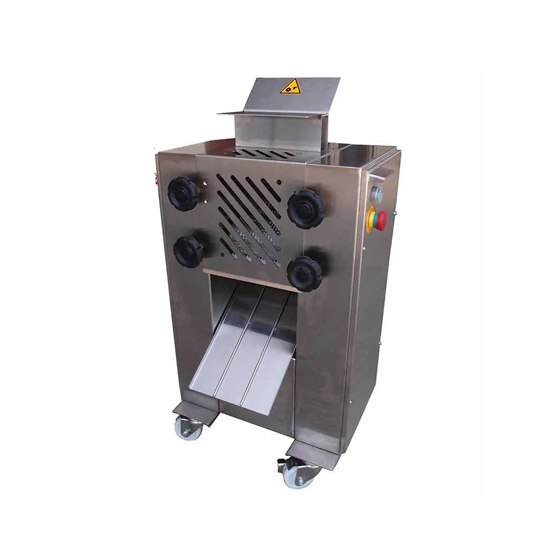
| Technical Parameters: | |
| Overall dimensions: | 410×510×920mm |
| Voltage: | 380V |
| Power: | 2.2kW |
| Production: | 300-500kg/h |
| Maximum size of wheel material: | 200mm |
| Material thickness: | 1-20mm |
| Customization: | customizable |
Meat slicing machines are essential tools in commercial kitchens, food processing plants, and even home kitchens for efficiently cutting meats into uniform slices, strips, or cubes. Below is a detailed breakdown of their types, working principles, selection criteria, operation, and maintenance.
| Type | Features | Applications |
|---|---|---|
| Horizontal Meat Slicer | - Electric-driven with pressure control system - High-hardness blades for tough meats - Adjustable cutting thickness | - Processing large meat blocks (beef, lamb) - Suitable for butcher shops, supermarkets |
| Vertical Meat Slicer | - Blade perpendicular to cutting direction - Maintains meat’s original shape - Rotary slicing mechanism | - Producing uniform thin slices - Used in delicatessens, sandwich shops |
| Rotary Meat Slicer | - Compact design with high efficiency - Uniform cutting thickness - Suitable for large-volume processing | - Commercial kitchens, food factories - Ideal for slicing frozen or fresh meats |
| Hand-Cranked Slicer | - Manual operation - Simple structure, easy to use - Low cutting efficiency | - Small restaurants, home kitchens - Limited to small meat portions |
| Automatic Meat Slicer | - Fully electric-driven - High cutting speed - Adjustable for different cuts | - Large-scale food processing - Versatile for beef, pork, chicken, etc. |
| Frozen Meat Slicer | - Specialized for frozen meat blocks - Precision cutting with adjustable thickness | - Meat processing plants - Producing slices for hot pot, shabu-shabu, etc. |
High-Speed Rotating Blades: The machine uses electric motors to drive blades at high speeds, slicing meat as it passes through.
Adjustable Cutting Thickness: By modifying the blade spacing or cutting table position, users can control slice thickness.
Specialized Design: Some models include grinding mechanisms to maintain blade sharpness, ensuring consistent cutting quality.
Material Quality: Opt for 304 stainless steel (food-grade, corrosion-resistant, and easy to clean).
Functionality: Choose models with multiple capabilities (e.g., slicing, dicing, shredding) if versatility is needed.
Noise Level: Low-noise operation indicates a high-quality motor and better user experience.
Safety Features: Look for designs like hand guards to prevent injuries during operation.
Brand Reputation: Select well-known brands with reliable after-sales service and warranty support.
Pre-Use Setup:
Clean the machine with warm water before first use (avoid wetting the motor).
Ensure proper grounding for electrical safety.
During Operation:
Start the motor and verify blade rotation direction (correct if reversed).
Feed meat evenly, avoiding bones or hard objects to prevent damage.
For slice-only mode, remove the upper blade set if applicable.
Post-Use Cleaning:
Turn off the power and disassemble removable parts.
Clean with hot water and neutral detergent, then dry thoroughly.
Apply a thin layer of food-grade oil to blades to prevent rust.
Daily Cleaning: Remove meat residues after each use to prevent bacterial growth.
Regular Inspections: Check power cords, plugs, and blades for wear or damage.
Blade Maintenance: Sharpen or replace dull blades promptly to maintain cutting efficiency.
Storage: Store in a dry, corrosion-free environment when not in use.
Safety First: Always disconnect power before performing maintenance tasks.
Commercial Kitchens: Slicing meats for sandwiches, hot pot, or barbecue.
Food Processing Plants: High-volume production of meat slices, strips, or cubes.
Home Use: Convenient for preparing meals with uniformly sliced meats.
Avoid Bones: Never process meat with bones to prevent motor or blade damage.
No Overloading: Follow the machine’s capacity limits to ensure safe operation.
Emergency Stop: Familiarize yourself with the emergency shut-off mechanism.
By understanding these aspects, you can select, operate, and maintain a meat slicing machine effectively, ensuring safety, efficiency, and longevity.